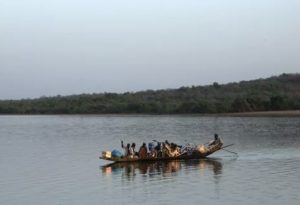
1. River Niger – 2,597 Miles
With a length of up to 2,597 miles, the River Niger, one of the most well-known rivers, flows through four additional African nations in addition to covering the Niger Delta regions in the southern portion of Nigeria. The River Niger is the longest river in Nigeria and the longest river in West Africa. It is also the most significant river in West Africa. The River Niger, which is the third-longest river in Africa after the River Nile and the Congo River, which are the first and second-longest rivers, respectively, serves as a transit route for the nations it crosses.
2. River Benue – 870 Miles
The River Niger and the River Benue create a tributary, making the River Benue the second-longest river in Nigeria. It travels 870 kilometers during its journey. The river originates on the Adamawa plateau and is shared by Nigeria and Cameroon.
3. Kaduna River – 342 Miles
The third-longest river in Nigeria is the Kaduna River, one of the top rivers in terms of length. The Kaduna River is a tributary of the 550-kilometer-long Niger River, just like the River Benue is. The name ‘Kaduna River’ was given to the river because of where it is located and because crocodiles are the most common aquatic species that inhabit it.
4. Gongola River – 330 Miles
In the northeastern region of Nigeria, there is a river called the Gongola. It travels 330 miles and is the fourth-longest river in Nigeria. The River Benue serves as its principal tributary. The river’s tributaries and upper course are seasonal, and the Dadin Kowa Dam and the Kiri Dam below it both dam the river’s lower sections. This aids in reducing the peak of an upstream flood.
5. Cross River – 304 Miles
One of Nigeria’s longest rivers, Cross River, may be found in the country’s southeast. The well-known Cross River State in Nigeria is named after this river. It travels through several well-known cities in Nigeria, including Oron, Calabar, and several locations in the Niger Delta region of Nigeria, before beginning in Cameroon from the Manu River.
6. Yobe River – 200 Miles
The 200-mile-long Yobe River, also known as the Komadougou Yobe or the Komadougou-Yobe, runs through Lake Chad, Niger, and Nigeria. It is one of Nigeria’s longest rivers and receives tributaries from the Hadejia, Jama’are, and Komadugu Gana rivers.
7. Sokoto River – 199 Miles
With a length of 199 miles, the Sokoto River ranks seventh among all rivers in Nigeria. The river, which was once known as Gublin Kebbi, is found in the northwestern region of the nation. It contributes to the River Niger as well. The Sokoto River passes through well-known cities in NorthWestern Nigeria, including Funtua, the capital of Katsina State, Gusau, the seat of Zamfara State, Sokoto, the state capital of Sokoto, and Birnin-Kebbi, the seat of Kebbi State.
8. Osun River – 166 Miles
In Yorubaland, the Osun River is the most well-known river. It originates in the southwestern region of Nigeria and flows into the Lagos Lagoon and the Atlantic Gulf of Guinea through the majority of the South-Western states. The River Osun is the largest river in
Southwestern Nigeria and the eighth longest river in all of Nigeria, with an approximate length of 166 miles. It is one of several rivers in Yoruba land that were allegedly formerly women who changed into flowing waters as a result of being terrified or enraged by a terrible incident.
9. Zamfara River – 155 Miles
One of Nigeria’s longest rivers, the Zamfara, flows across the country’s northwestern region. Zamfara State is where it first appeared. The Zamfara River flows through many states in northern Nigeria, including Kebbi State, Sokoto State (Sokoto River), and Birnin Kebbi in Kebbi State, across a distance of around 155 miles.
10. Anambra River – 131 Miles
The Anambra River, ranks as the country’s tenth-longest river. This river is a significant one in Nigeria and plays a significant role in the region of Igboland in the country’s southeast. This river, which runs for 130 kilometers, is where the name of the state of Anambra originates. Natives who live close to the Anambra River refer to it as the Onwubala or OmaMbala. Below Lokoja, it serves as the River Niger’s primary feeder. Through a number of exits that make up the 25,000 km2 Gulf of Guinea, the flow of the Anambra River is discharged into the Atlantic Ocean.
In conclusion, These rivers significantly improve both the daily lives of those who live close to them and the economy of Nigeria. The water produced by these rivers is essential to the communities that live nearby since it allows them to irrigate their crops, do routine household tasks, and more. As Nigeria’s longest river, the River Niger also provides a significant amount of fishing opportunities and transportation services, helping to lower the nation’s high unemployment rate.
